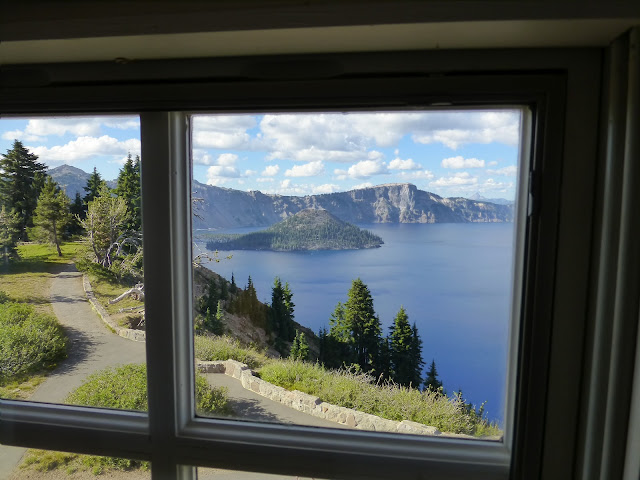CRATER LAKE NATIONAL PARK
I thought Crater Lake would be Lake Tahoe without the lakefront mansions or the highrise casinos, but other than the clarity of the water, they don't have much in common. Rim Road circles Crater Lake at about 500 to 1000 feet above the lake surface and the slope of the caldera wall makes access to the lake nearly impossible. In no way can Crater Lake be considered a recreational lake.
The only route to lake level is the Cleetwood Cove trail which is rated as one of the park's more strenuous hikes. It's said to be the equivalent of 65 flights of stairs and locals joke that the trail is one mile down to the water and 12 miles back up to the rim. Only at the bottom of the trail can visitors swim (it's very cold), fish (stocked in the late 1800's), or get onto the lake in one of the tour boats (originally brought in by helicopter).
After our own hike and tour we were glad we had a room nearby at the Crater Lake Lodge. This historic hotel has only 71 rooms and perches on the rim of the crater. Our room was an oddly shaped thing but it certainly had a spectacular view.
 |
| View from Lodge Room |
The lake is a dark blue color due to its depth and the clarity of the water. The water simply absorbs every other color. The only sources of water for the lake are rain and snow and we were told that the water is pure enough to be considered distilled.
The large island in the lake is Wizard Island which is actually a volcano inside the volcano. There is another volcano in the lake, Merriam Cone, but it never grew large enough to break the surface. This gives you some idea of the size of Crater Lake and, in fact, before its eruption and collapse, Mt. Mazama was the highest and largest mountain in what is now Oregon.
On our boat tour, we visited the other island in the lake, the Phantom Ship. While Wizard Island is the youngest volcanic feature of the park, the Phantom Ship is the oldest. Given the size of the lake, the Phantom Ship looks small, but looks can be deceiving. The island is 500 feet long and 16 stories at its highest point.
 |
| The Phantom Ship |
 |
| Crater Lake Trolley |
What I found most surprising was that, in geologic time, the crater was created just yesterday. Eruptions in the Cascade range go back 30,000 years and as recently as Mt. Lassen and Mt. St. Helen in the 20th century, but it's astonishing that Crater Lake was created just 7,000 years ago and that archeological finds of sandals covered with Mt. Mazama ash, as well as native stories passed down through hundreds of generations, indicate that humans inhabited the area during this cataclysmic event.
Crater Lake is an amazing place where the clarity of the water is matched by the clarity of the air. We live just down the road from UNR's astronomical observatory and are used to clear nights thanks to our afternoon zephyrs and the dark sky initiative, but Crater Lake has a night sky that seems close enough to touch. There is a famous photograph of the Milky Way over Crater Lake and, earlier this year, solar flare activity resulted in a rare photograph of the Aurora Borealis over Crater Lake. Sunrise and sunset are nearly as impressive.
 |
| Caldera Sunrise |
LAVA BEDS NATIONAL MONUMENT
Tucked into the nearly inaccessible northeast corner of California, the lava beds were created by lava flows from the numerous shield volcanoes in the area. It is an other-worldly place most famous for its lava tube caves. There are 20 open to public exploration and 200 more serving as home to 40 species of bats and other creatures. They vary in size with some as large as traffic tunnels.
 |
| The Devil's Homestead |
Beyond the natural environment, the area is home to two historical sites that tell interesting, and largely forgotten, stories from our history. The Modoc Indian war was fought here in 1872-1873. Even contemporary accounts saw this as the romantic adventure of Captain Jack and his band of 52 Modocs holding off a US Army force 8 times their number and armed with artillery. But, when it was all over, it was merely a tragedy on both sides that only highlighted the folly of President Grant's Indian policy that forced native peoples together onto reservations without regard to the enmity between the different tribes.
Lava Beds is also home to the Tule Lake internment camp from World War II. This camp became the site for the so-called "No-No" trouble-makers and it soon had the largest population of all ten camps despite the fact that no Japanese-American was ever found to have committed any treasonous act. Today there are only remnants of the camp left as it was systematically dismantled after the war. (You might think it was out of embarrassment, but they simply wanted to get the camp materials into the post-war supply chain.)
Finally, the area is also home to the Tule Lake National Wildlife Refuge, a major stop on the western migration route of waterfall and other birds and famous for its Bald Eagle population.
For Additional Photos,
Go To: